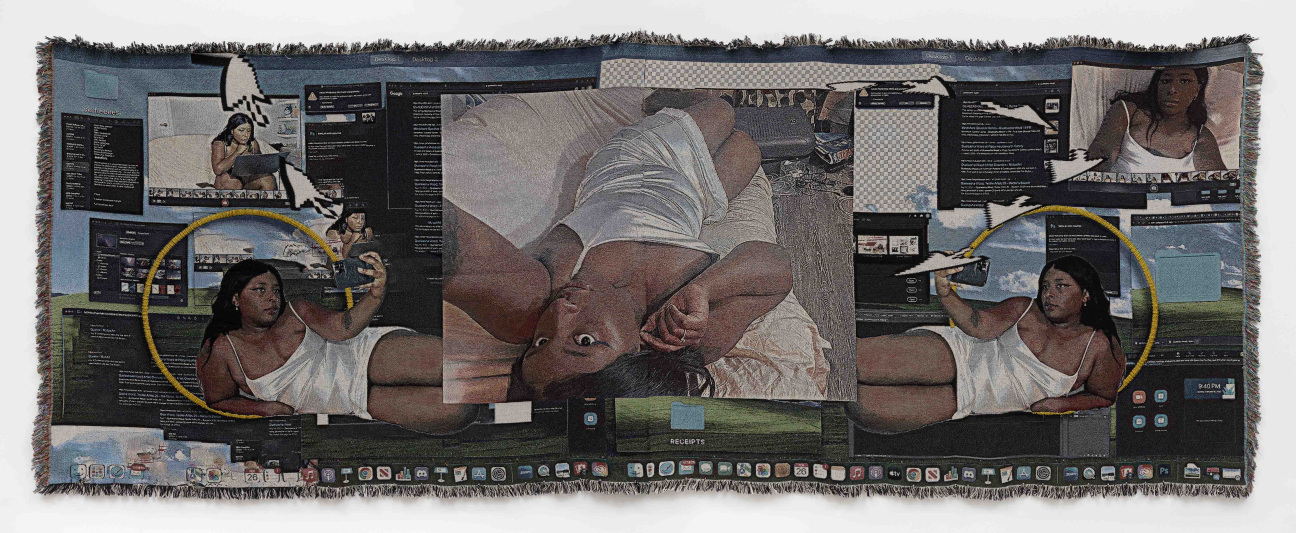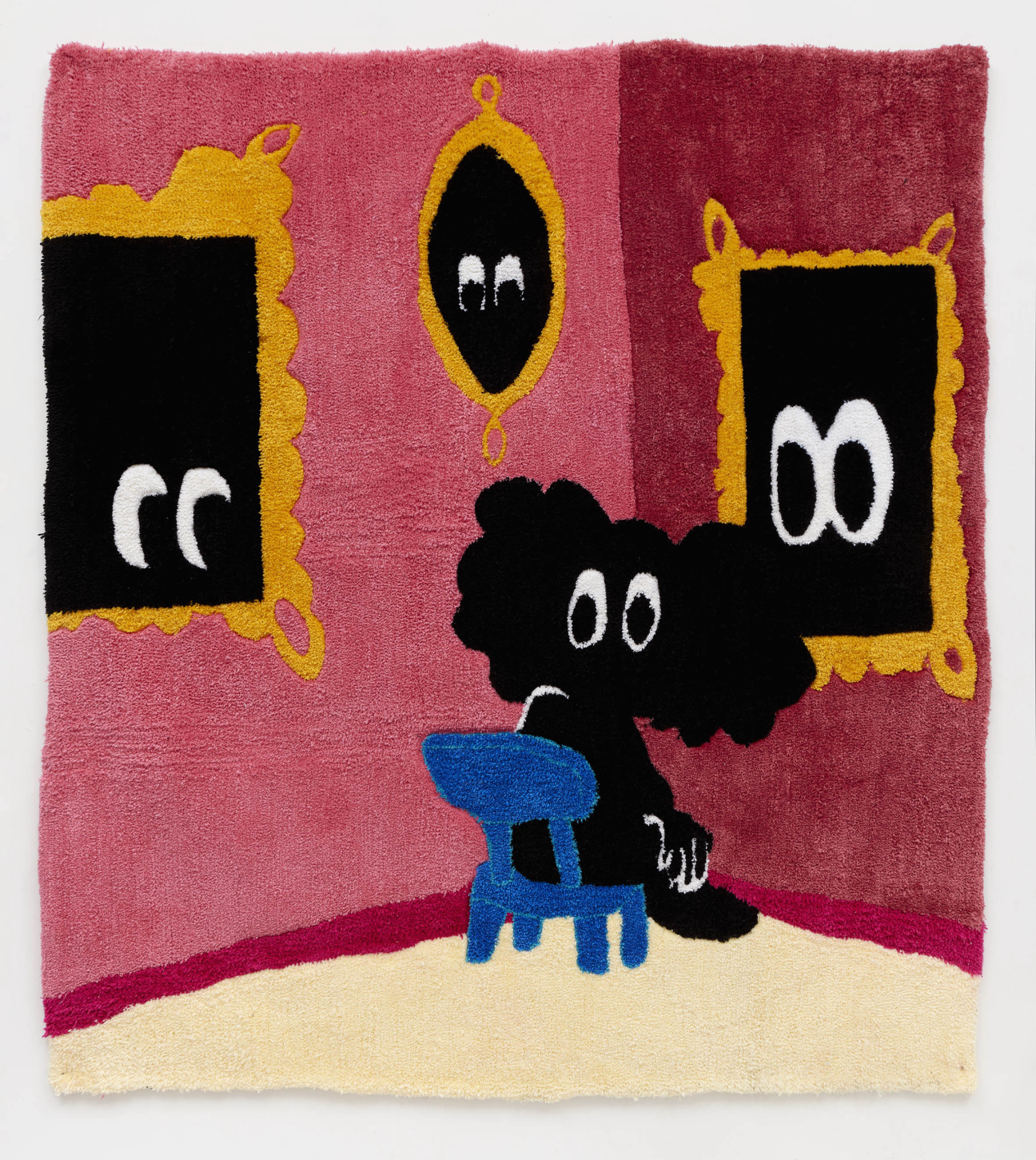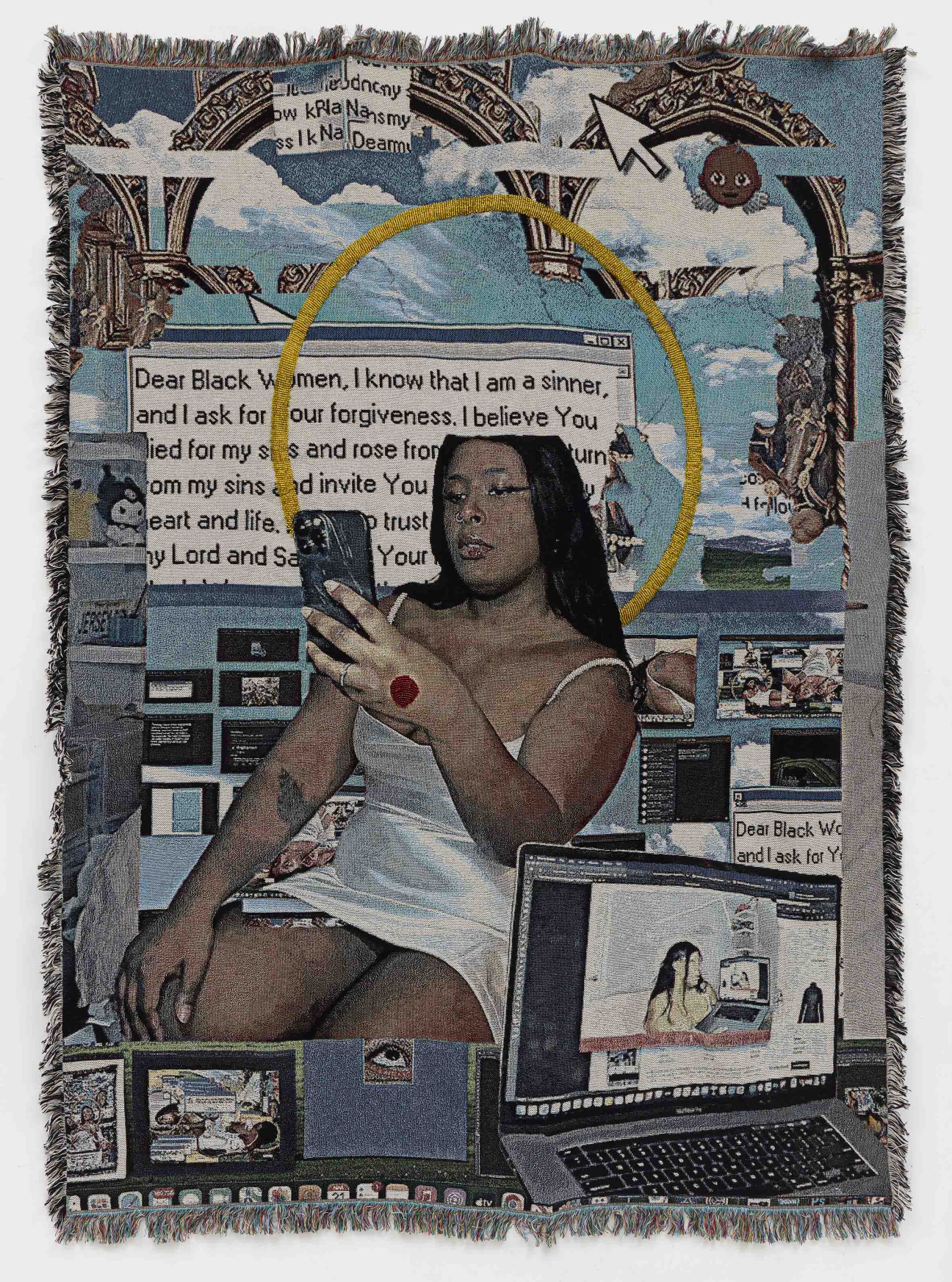
Qualeasha Wood got her first computer at age five. The artist, who lives in Philadelphia and works in Brooklyn, has made the Internet—the site of both paradoxical perversities and endless possibilities—her canvas since that time. She only happened upon jacquard weaving, which is incidentally understood as an ancestor to modern computing, years later, while studying at the Rhode Island School of Design. Pixels, stitches—both carry the potential to hold, and obscure, stories, identities, and symbols. Wood's work sits at the crux of those containers, braiding a concern with digital fetishization with its embodied consequences. Doxxed twice by the age of 20, Wood has become the subject of mainstream art world fascination since last year, when her tapestry The [Black] Madonna/Whore Complex, 2021, was acquired by the Metropolitan Museum of Art. Ahead of her first European solo show, “TL;DR,” which opens at Pippy Houldsworth Gallery in London this Friday, CULTURED called up the artist to talk Christian dad rock, being the loudest in the room, and making work that grinds people's gears.
CULTURED: How are you feeling about your first European solo opening?
Qualeasha Wood: It’s been a long time coming. I definitely felt like there was a lot more pressure this time around, and I think I rose to the challenge. I’ve also never been to Europe, so it’s really exciting to see how my work is perceived in another context.
CULTURED: What references were you drawing from in making these works?
Wood: The largest tapestry [in the show] is titled All Around Me, after a Flyleaf song. Somehow, Christian dad rock was really influential for me. I was listening to Lana Del Rey’s Norman Fucking Rockwell! and Chemtrails over the Country Club. She has a way of making escapism and survival and struggle sound like the most beautiful thing you could ever experience. I was watching Girl, Interrupted on a loop. But also Jennifer’s Body and Pulp Fiction… just unpacking my relationship to the femme fatale trope. I looked at all of these women in pop culture who served as some sort of “crazy girl.”
During the pandemic, I was reading Calvin Warren’s “Onticide,” which is a text that talks about being a Black, queer derelict object, and how, at the intersection of queerness and Blackness, there’s this violence that renders the Black, queer body as not autonomous. I had a really hard time grappling with that, mainly because I felt a lot of it was true. I was also reading about Bill Brown’s “thing theory,” and [Martin] Heidegger’s explanation of how an object becomes a thing and can become an object again. So I started thinking about the Black body in this transitional period of becoming a thing and becoming an object, and how there might be some sort of autonomy in being malleable.
And also what it feels like to come out on the other side of something. Ultimately, that’s what the Internet has served as for me, right? As this portal to another way of being. It’s an experience that forces you to make your way in it, but it also comes with a lot of preconceived notions of what you should and shouldn’t do. The work in this show was really me processing my self identity in the last two years, and how much that has changed even since making The [Black] Madonna/Whore Complex, 2021.
I finally accepted that I have body dysmorphic disorder. That’s something that has been going on since childhood, but I never had the space to understand or explore it. I had my career rise, and I found myself feeling really lost. I stopped taking selfies outside of work. In some ways, my work is only successful based on how attractive I am in a certain amount of time. At my first Art Basel, I was in my booth sitting there with everyone else, and people kept coming up and asking me, “Oh, who’s the artist?” I’m sitting right in front of your face!

CULTURED: It’s crazy what the art world does to young artists who reach success very early.
Wood: A lot of artists, young artists especially, are just faced with this challenge of what do they value more: money and fame, or time and sanity? People within the art world try to make it seem like it’s impossible to have everything that you want. But for me, the work is so deeply personal that I have to put myself first above anything else. My time at the Studio Museum in Harlem really taught me this. The people there were like, “We’ll say no for you, we will be bodyguards for you and talk to whoever you need.” Spending a year in that residency was a big push to focus on myself and make the work I feel needs to be made versus making the work that I could make.

CULTURED: Your current practice as an artist is inextricable from Internet culture and textiles. Can you tell me about how you first encountered both?
Wood: My [earliest interaction with art] was with drawing. I didn’t really think about all the art I was experiencing within my house. My great-grandmother crocheted and knitted a good majority of my stuffed animals. So that was my earliest relationship with textiles.
I grew up as a kid who was really sheltered. I spent most of my life inside. Outside of school, I didn’t like to play outdoors. I used to always beg to be on my computer, and when I got to high school, I really spent most of my life on the Internet. That was when I would say my origin story with textiles came into play without me knowing it. I was really involved in meme groups, so I was using Photoshop and collaging every day while talking to people nonstop and positioning myself in these pseudo-powerful positions as an admin across so many pages. By the time I got to Rhode Island School of Design, I was used to being the loudest in the room.
Originally, I was an illustration major. But then I realized I didn’t like drawing because it was so elitist in terms of what was “good” and “bad” drawing. I took a lithography class and really liked the process, just being able to take an image and then work it through a million steps and then have it come out bigger, better, and more interesting. I wanted to change to printmaking, and my mom and dad were like, “No, we don’t know what that is. It doesn’t make any sense.” I was like, Maybe I should leave if my parents aren’t going to let me go into printmaking. Maybe I’m the problem.

CULTURED: How did that change?
Wood: I had a friend and mentor who one day texted me, “What are you doing?” And I was like, “I’m in this drawing class.” And she was like, “Oh, do you wanna go pick up Faith Ringgold with me?” She wrote my teacher an email, I left, she picked me up in a limo, and we went to the Providence Amtrak station to get Faith. It was like meeting a celebrity, but it also felt like I was talking to my grandmother. We talked and laughed and took a selfie. I remember she was not pleased with it. She looked at the photo and said, “That looks nothing like us, that’s not how we look. Look at how it’s changing our skin color. Everything is wrong with this photo.”
I was talking to her about what I was doing, and I told her I really wanted to go into printmaking. And she said, “You should… If I could have gone into any major I wanted, I would have taken the opportunity to study more and go to more classes. That wasn’t available for me, so you need to take the opportunity.” The next day my friend was like, “I have something for you.” It was a signed copy of Tar Beach. Faith wrote, “Dear Qualeasha, you can be a printmaker, and you can fly.” The rest is history.
CULTURED: Then there was another shift towards textiles, right?
Wood: With jacquard, it came from two places. Once, I was in the cafe on campus, and all the textiles majors were there holding jacquard weavings. And I was like, “What is that?” And my friends were like, “Oh it’s jacquard, you put it in a software, and then you weave.” And I thought it seemed so cool because at the time I was obsessed with putting photos on everything. Then I went home for winter break and was at my grandmother’s house. It was time for me to sleep, and she brought me out this blanket. It was so hideous, cute, and corny at the same time. I was just laying there in the middle of the night staring at it, wondering if this is the same process as what my friends showed me.
It just came from this obsession with the material and wanting to speak to something else. The thing that really did it for me was it was so familiar. The first time I showed it to my mom, she felt like she understood what was going on. It was the first time that I saw people around me find my work interesting. Not the people I went to school with, but the people from my hometown.

CULTURED: Let’s fast forward to 2022, when you became one of the youngest artists to have work acquired by the Metropolitan Museum of Art. What impact has that achievement had on you?
Wood: I always say it's a blessing and a curse. It was also the only news that people I knew who had no clue about art were able to understand. When the acquisition happened, it felt like winning the Super Bowl. It did have its push backs because it put 1000 times more pressure on every other thing I was doing. I was put under a microscope. Everyone wanted that piece, The [Black] Madonna/Whore Complex, 2021. To this day, I’ll be on a call discussing my work with people, and they’ll be like, “We’re looking for something that’s more like your 2021 work.”
It’s a great piece of art, but to be in the mental space that I was in then is not possible at this moment in time. I was really angry when I made that piece. At that time, everyone wanted a Black artist because it felt like the thing to do. Some of my friends got pedestaled, their work skyrocketed, and then they got dropped. The second the performative nature of it is over, people stop caring. [The acquisition] just exposed me to a lot of people that weren’t really interested in the work, but in the emotions. There was no better place for that piece to go than the Met, but I burned out really quickly. I'm constantly getting asked, “Why aren’t you making more? Why can't you do this exhibition? We talked in January, it's April, you said you'd have something? Where's your archive?” I felt like I couldn't enjoy it; it had a really short shelf life.

CULTURED: What information do you want the audience to walk away with from “TL;DR”?
Wood: I want certain people to walk in and leave with their head held a little higher. I want people to stop and think about something larger than themselves. I want it to feel like when you hear a song, and it doesn't matter if it's good or bad. It's catchy. That's how I want my work to live in memory. Something that really grinds people's gears. I want to promote humanity. Some people should feel a little embarrassed. Some people should feel like, Maybe I'm somebody who needs to be called out.
But if one 18-year-old Black girl who's trying to get her shit together goes into the gallery and is like, “This made me feel so special, this made me feel heard,” that's really all I need, and everything else is just a bonus.
“TL;DR” is on view from May 5 to June 4, 2023 at Pippy Houldsworth Gallery in London.










 in your life?
in your life?

